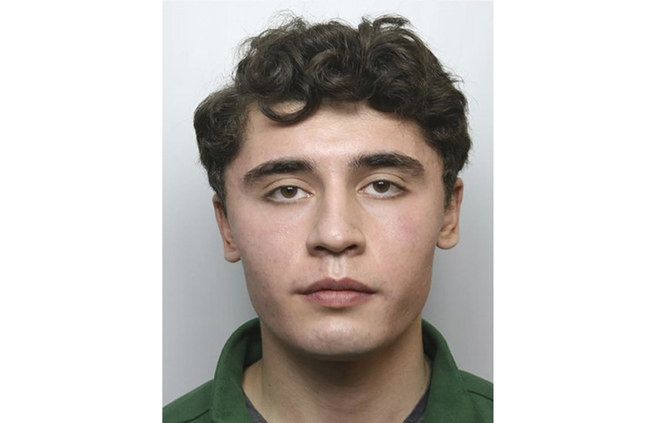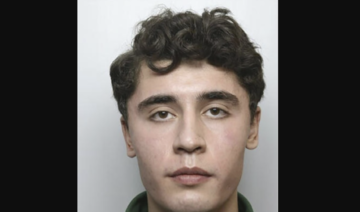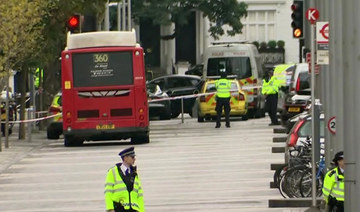LONDON: A former British soldier facing terrorism charges who snuck out of a London prison on a food delivery truck was captured Saturday, police said.
Daniel Abed Khalife was nabbed while riding a bicycle along a canal path west of London after a four-day manhunt.
Khalife escaped from the Wandsworth Prison kitchen Wednesday and got outside the gates by strapping himself to the bottom of a catering truck.
Khalife, 21, was awaiting trial on charges of violating Britain’s Official Secrets Act by gathering information “that could be useful to an enemy” and planting fake bombs at a military base. He was discharged from the British army after his arrest earlier this year and denied the allegations. His trial is set for November.
The breakout ignited a storm of criticism as political opponents linked the escape to years of financial austerity by the United Kingdom’s governing Conservative Party. The government said an independent investigation would determine how Khalife escaped the medium-security prison that opened in 1851 during the reign of Queen Victoria.
“We need answers about how on earth a prisoner charged with terror & national security offenses could have escaped in this way,” Yvette Cooper, a member of the Labour Party in the House of Commons, wrote on social media Saturday.
Prime Minister Rishi Sunak thanked the police and public and said the inquiry would get to the bottom of how Khalife got away.
The escape prompted extra security checks at major transport hubs, particularly in and around the Port of Dover, the main boat crossing from England to France, and led to the shutdown of a major highway at one point.
London counter-terror police had offered a 20,000 pound ($25,000) reward for information leading to his arrest. It was not immediately clear if anyone was in line for the reward.
Police on Friday had announced a breakthrough in the search after a witness reported seeing Khalife at a busy intersection near the prison shortly after the escape.
Metropolitan Police’s counterterrorism commander Dominic Murphy wouldn’t say if the sighting was confirmed by surveillance cameras, but London has one of the most robust security camera networks in the world and any footage could have helped track his whereabouts.
“In terms of the investigation, it really gathered momentum yesterday afternoon, with a number of calls from the public, but really took a different course last night, when we did an intelligence-led search in the Richmond area in the early hours of this morning,” Murphy said. “Whilst we didn’t find him at that search, while we were at that search, we had a number of calls from the public over the next hour or two, giving us various sightings of him.”
Police had received reports he was seen in the Chiswick area of west London and they descended there on Saturday morning, with police cars and vans swarming the area and helicopters hovering overhead.
Paul Wade said he opened his curtains to find five police officers outside his home.
“They said ‘I expect you know why we are here,’” he said. “They were checking everybody’s gardens.”
But Khalife was nowhere near there when a plainclothes officer ultimately made the collar in the late morning, Murphy said.
Khalife was pulled off a bicycle along the canal near the community of Northolt, about 10 miles (16 kilometers) from where he escaped.
Murphy said he was cooperative when arrested. He now faces additional charges of being unlawfully at-large and being an escaped prisoner.
Terrorism suspect who escaped from London prison is captured while riding a bike
https://arab.news/vgen9
Terrorism suspect who escaped from London prison is captured while riding a bike

- Daniel Abed Khalife was on the run four days before a massive search managed to nab him Saturday
A look at high-profile political assassinations and attempts this century

- An apparent assassination attempt on Slovakia’s prime minister Robert Fico rocked the small country and the rest of Europe on Thursday
- In 2007, Pakistan lost its first female prime minister, Benazir Bhutto, in a gun and bomb attack at a rally in the garrison city of Rawalpindi
Slovakia’s prime minister Robert Fico was gravely injured in an apparent assassination attempt that rocked the small country and the rest of Europe just weeks before an election.
Here’s a global look at other notable political assassinations and attempts during the 21st century:
— Sept. 1, 2022: Argentina’s then-Vice President Cristina Fernández is targeted by a man who reportedly aimed a handgun at point-blank range toward the politician in what government ministers characterize as an assassination attempt.
— July 8, 2022: Japanese former Prime Minister Shinzo Abe is assassinated by a gunman who opened fire on him as he delivered a campaign speech on a street in western Japan.
— Nov. 6, 2021: Iraqi Prime Minister Mustafa Al-Kadhimi survives an assassination attempt when two armed drones target his residence in Baghdad’s Green Zone area. While Al-Kadhimi is uninjured, seven of his security guards are injured in the attack.
— Oct. 15, 2021: British lawmaker David Amess is stabbed to death by a Daesh supporter while meeting with voters.
— July 7, 2021: Haitian President Jovenel Moïse is assassinated by gunmen in an overnight raid on his Port-au-Prince home. His widow, Martine, ex-prime minister Claude Joseph and the former chief of Haiti’s National Police, Léon Charles, among others, are indicted in his killing in February 2024.
— April 20, 2021: Chad President Idriss Deby Itno is killed while battling rebels in the north. Hours earlier he had been declared the winner of an election that would have given him another six years in power.
— Aug. 4, 2018: Drones armed with explosives detonate near Venezuelan President Nicolas Maduro in an apparent assassination attempt while he is delivering a speech to hundreds of soldiers being broadcast live on television. Six people are later arrested in connection with the attack.
— Dec. 19, 2016: Russia’s ambassador to Turkiye Andrei Karlov is shot dead by a Turkish policeman shouting condemnation of Russia’s military role in Syria, in front of a shocked gathering at a photo exhibit. The gunman was later killed in a shootout with police.
— July 15, 2016: A group of Turkish soldiers using tanks, warplanes and helicopters launch a plot to overthrow Turkiye’s president and government. The coup attempt fails. One year later, 40 people are sentenced to life in prison after being convicted on charges that include attempting to kill President Recep Tayyip Erdogan.
— June 16, 2016: British lawmaker Jo Cox is shot and stabbed to death by a far-right supporter in the English village of Birstall, part of her constituency.
— Feb. 6, 2013: Tunisian left-wing opposition leader Chokri Belaid is fatally shot outside his Tunis home. His killing — followed six months later by that of another left-wing leader, Mohammed Brahmi — plunged Tunisia into political chaos. Four people are sentenced to death and two others to life in prison in March 2024 for their roles in his death.
— Oct. 20, 2011: Longtime Libyan dictator Muammar Qaddafi is hunted and summarily killed by insurgents after being toppled in a NATO-backed uprising.
— Jan. 8, 2011: US Rep. Gabrielle Giffords survives an assassination attempt after being shot by a man in an Arizona grocery store parking lot while meeting with constituents. Giffords’ injuries are so significant that she has to re-learn how to walk and talk. The attack kills six other people and wounds 11 more.
— March 2, 2009: Guinea-Bissau President Joao Bernardo Vieira is killed by renegade soldiers in his palace, hours after a bomb blast killed his rival in the West African nation.
— December 27, 2007: Benazir Bhutto, the first female prime minister in a Muslim-majority country as well as Pakistan’s second nationally elected prime minister, is shot at and then fatally attacked by a suicide bomber at a political rally in Rawalpindi, Pakistan.
— Feb. 14, 2005: Lebanese Prime Minister Rafik Hariri is killed by a suicide truck bomb on a seaside boulevard in Beirut. Another 21 people die and 226 are wounded in the attack, which is seen by many in Lebanon as the work of neighboring Syria.
— March 12, 2003: Serbian Prime Minister Zoran Djindjic is shot dead in front of the Serbian government headquarters in Belgrade. He was a key leader of the revolt that toppled former President Slobodan Milosevic in October 2000. Twelve people were later convicted in connection with the killing, which was carried out to halt his pro-Western reforms, according to a Serbian court ruling.
— July 2, 2002: French President Jacques Chirac survives an assassination attempt by a far-right right supporter who shoots at him and misses during Bastille Day celebrations on Paris’ Champs-Elysees. Chirac is uninjured.
— May 6, 2002: Dutch politician Pim Fortuyn is gunned down in a northern Netherlands city, days before a general election in which he was a candidate, by an animal rights activist.
— June 1, 2001: Nepal’s King Birendra is killed when his son, Crown Prince Dipendra, opens fire on his family in the royal palace. The dead include Queen Aiswarya, a prince and five others. Officials said the shooting followed a dispute over the prince’s marriage.
— Jan. 18, 2001: Congo President Laurent Kabila is assassinated in the presidential palace in the capital, Kinshasa, by one of his bodyguards, who is killed minutes later by security forces.
Pakistan establishes two hospitals, ten dispensaries in Makkah and Madinah for Hajj pilgrims

- Pakistan Hajj official says over 400 doctors and paramedics will serve pilgrims during Hajj 2024
- Over 16,000 Hajj pilgrims have arrived in Saudi Arabia weeks before Islamic pilgrimage starts
ISLAMABAD: Pakistan has established two hospitals and 10 dispensaries in the holy cities of Makkah and Madinah to provide health care for Hajj pilgrims, the head of the country’s medical mission in Saudi Arabia confirmed on Thursday, as hundreds of pilgrims arrive daily in the Kingdom ahead of the annual Islamic pilgrimage.
Pakistan’s Ministry of Religious Affairs (MoRA) has confirmed that more than 16,000 pilgrims from the country have arrived in Saudi Arabia weeks before Hajj 2024 begins.
This year, 179,210 Pakistanis will perform Hajj under government and private schemes. Pakistan kicked off a month-long flight operation last week, with five airlines— PIA, Saudi Airlines, Airblue, Serene Air, and Air Sial— operating 259 flights from eight major Pakistani cities to Jeddah and Madinah until June 9.
“We have established two main hospitals and ten dispensaries in Makkah and Madinah,” Brig. Jamil Lakhiar, the director of Pakistan’s Hajj Medical Mission, told Arab News from Madinah.
“One main hospital and eight dispensaries are in Makkah, while one hospital and two dispensaries are in Madinah,” he shared.

He said Pakistani pilgrims’ residences in Makkah have been divided into nine zones. One zone has the main hospital in it while each of the remaining eight zones have a dispensary each.
Lakhiar said around 400 doctors and paramedics have been selected this year for the Hajj Medical Mission, who were gradually arriving in Saudi Arabia with pilgrims to perform their duties.
The Pakistani official said members of the medical mission were selected by the religion ministry on a pre-defined formula based on merit. He said the mission comprised 70 percent of civilians while 30 percent were selected from the armed forces.
“At the hospitals, we have specialists including cardiologists, gynecologists, pediatricians, pulmonologists, dentists, and others,” Lakhiar said. He said both hospitals were equipped with X-ray, ultrasound, and lab testing facilities where minor procedures could be performed.

He said patients suffering from serious ailments are referred to Saudi hospitals for further treatment.
“In every dispensary, one doctor, two paramedics and one pharmacist will be present round the clock in different shifts,” Lakhiar said, adding that each dispensary has an ambulance as well.
“So far in Madinah, we have treated more than 500 Pakistani pilgrims for various minor issues,” he disclosed.
The official said all treatments, tests and medicines were provided free of cost to pilgrims.
“Every doctor and paramedic has to return after 45 days, that is why their arrival is staggered so that when one leaves, there will always be others available to replace them until the last flight,” Lakhiar said.

UN reports improved prospects for the world economy and forecasts 2.7 percent growth in 2024

- The mid-2024 report says the world economy is now projected to grow by 2.7 percent this year and by 2.8 percent in 2025
UNITED NATIONS: The United Nations reported improved prospects for the world economy since its January forecast on Thursday, pointing to a better outlook in the United States and several large emerging economies including Brazil, India and Russia.
According to its mid-2024 report, the world economy is now projected to grow by 2.7 percent this year – up from the 2.4 percent forecast in its January report – and by 2.8 percent in 2025. A 2.7 percent growth rate would equal growth in 2023, but still be lower than the 3 percent growth rate before the COVID-19 pandemic began in 2020.
“Our prognosis is one of guarded optimism, but with important caveats,” Shantanu Mukherjee, director of the UN’s Economic Analysis and Policy Division, told a news conference launching the report.
The report pointed to interest rates that are higher for longer periods, debt repayment challenges, continuing geopolitical tensions and climate risks especially for the world’s poorest countries and small island nations.
Mukherjee said inflation, which is down from its 2023 peak, is both “a symptom of the underlying fragility” of the global economy where it still lurks, “but also a cause for concern in its own right.”
“We’ve seen that in some countries inflation continues to be high,” he said. “Globally, energy and food prices are inching upward in recent months, but I think a bit more insidious even is the persistence of inflation above the 2 percent central bank target in many developed countries.”

The UN forecast for 2024 is lower than those of both the International Monetary Fund and the Organization for Economic Cooperation and Development.
In mid-April, the IMF forecast that the world economy would continue growing at 3.2 percent during 2024 and 2025, the same pace as in 2023. And the OECD in early May forecast 3.1 percent growth in 2024 and 3.2 percent in 2025.,
The latest UN estimates foresee 2.3 percent growth in the United States in 2024, up from 1.4 percent forecast at the start of the year, and a small increase for China from 4.7 percent in January to 4.8 percent. for the year.
Despite climate risks, the report by the UN Department of Economic and Social Affairs forecasts improved economic growth from 2.4 percent in 2023 to 3.3 percent in 2024 for the small developing island nations primary due to a rebound in tourism.
On a negative note, the report projects that economic growth in Africa will be 3.3 percent, down from 3.5 percent forecast at the beginning of 2024. It cited weak prospects in the continent’s largest economies – Egypt, Nigeria and South Africa – along with seven African countries “in debt distress” and 13 others at “high risk of debt distress.”
Mukherjee said the lower forecast for Africa “is particularly worrying because Africa is home to about 430 million (people) living in extreme poverty and close to 40 percent share of the global undernourished population” and “two-thirds of the high inflation countries listed in our update are also in Africa.”
For developing countries, he said, the situation isn’t “as dire” but an important concern is the continuing fall and sharp decline in investment growth.
Japan, US move ahead in co-developing hypersonic weapons interceptor as regional threats grow

TOKYO: Japan and the United States on Wednesday signed an arrangement to jointly develop a new type of missile defense system as the allies seek to defend against the growing threat of hypersonic weapons, which are possessed by China and Russia and being tested by North Korea.
The project was initially agreed between Japan’s Prime Minister Fumio Kishida and US President Joe Biden at their summit last August and reaffirmed between the leaders during Kishida’s April visit to Washington. The Glide Phase Interceptor is planned for deployment by the mid-2030s.
Wednesday’s agreement determines the allocation of responsibility and decision-making process, a first major step in the project, Japanese defense ministry officials said. They hope to decide on Japanese contractors and start the development process by March 2025.
Hypersonic weapons are designed to exceed Mach 5, or five times the speed of sound, posing a threat to regional missile-defense systems with their speed and maneuverability. Developing interceptors of them is a challenge.

Japan’s defense ministry called it a “pressing issue” and noted that hypersonic weapons in the region have dramatically improved in recent years.
Under the arrangement, Japan is responsible for developing a part at the interceptor’s tip that separates in space to destroy the incoming warhead, as well as its rocket motors, officials said.
Japan has earmarked 75.7 billion yen ($490 million) for initial development and testing of the interceptor, according to the defense ministry.
The cost includes making components for the two companies, Raytheon Technologies and Northrop Grumman, that are developing the weapon in a competition led by the US Missile Defense Agency. One will be chosen for the project.
The MDA has estimated the cost to develop the hypersonic missile interceptor will exceed $3 billion, including Japan’s share of $1 billion.
The interceptors will be deployed on Aegis-class destroyers, like the ship-to-air Standard Missile-3 that Japan previously co-developed with the United States.
Japan has been accelerating its miliary buildup as it stresses the need to fortify its deterrence against growing threats. Japan has also significantly eased its weapons export policy to allow co-developed lethal weapons to third countries.
___
This story has been corrected to say GPI stands for Glide Phase Interceptor, not Glide Sphere Interceptor.
___
Follow AP’s Asia-Pacific news at https://apnews.com/hub/asia-pacific
Swiatek into Rome Open final as trophy record beckons, Paul battles through

- World No. 1 Swiatek now stands one victory away from duplicating the Madrid-Rome clay trophy double achieved by Serena Williams 11 years ago
- American Paul reached a clay court semifinal for the first time in his career with a 7-5, 3-6, 6-3 upset of Hurkacz
ROME: Iga Swiatek won her 11th straight clay-court match on Thursday as the top seed moved closer to another record with a 6-4, 6-3 semifinal defeat of Coco Gauff at the Rome Open, after Tommy Paul earlier survived a chaotic ending to emerge victorious from his quarterfinal encounter with Hubert Hurkacz.
World No. 1 Swiatek now stands one victory away from duplicating the Madrid-Rome clay trophy double achieved by Serena Williams 11 years ago.
The 22-year-old Pole defeated third-seed Gauff for the 10th time in their 11 encounters, with her only loss in the series coming last summer in a Cincinnati semifinal.
Swiatek, a four-time Grand Slam winner due to defend her Roland Garros title starting a week from Sunday, will play the Saturday Rome final against either second-seed Aryna Sabalenka or American Danielle Collins.
The top seed spent one and three-quarter hours in dispatching Gauff, the reigning US Open champion.
Swiatek ended with 26 winners and broke four times.
“I’m not thinking about statistics or history,” she said after the victory. “I’m just playing day by day.
“It’s easier that way, it lets you play more freely.
“I’ll just try to play as good as possible in the final, no matter who it is.
“I won’t be thinking of any records, there is still work to do.”
On the men’s side, American Paul reached a clay court semifinal for the first time in his career with a 7-5, 3-6, 6-3 upset of Hurkacz.
The 14th seed is the first American to reach the final four at the Foro Italico since Reilly Opelka in 2021.
The momentum-shifting quarterfinal came down to the wire, with a 15-minute final game capping off nearly two and three-quarter hours on court.
Paul finally came through on his fourth match point as Poland’s Hurkacz sent a return long.
The match featured 13 breaks of serve, with Paul advancing with 29 winners and 41 unforced errors; and Hurkacz having 22 and 44 respectively.
“I started well but it got away from me in the second and start of the third,” Paul said. “I had to stick around in the match.
“I found the energy to get it going again. I was hitting my forehand bigger and with more intensity because Hubii can really crush the ball.”
Paul will play Nicolas Jarry in the semifinals after the 28-year-old Chilean stunned sixth seed Stefanos Tsitsipas 3-6, 7-5, 6-4 to reach his first Masters semifinal in Rome on Thursday.
Hurkacz, who knocked Rafa Nadal out in the Rome second round, was unable to get his massive serve up to speed as he faced Paul, winner over defending champion Daniil Medvedev in the fourth round.
Hurkacz won the clay title in Estoril last month and suffered only his third loss on clay this spring.


















